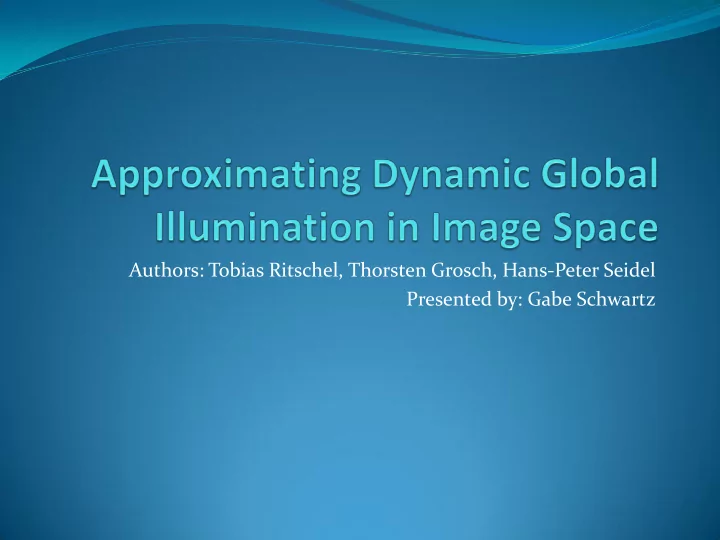

Authors: Tobias Ritschel, Thorsten Grosch, Hans-Peter Seidel Presented by: Gabe Schwartz
Goals Authors aimed to simulate global illumination in real time. Goal was an approximation, not physically correct. Used screen-space (frame buffer) data for speed and efficiency.
Background Global Illumination (GI): lighting contribution from indirect bounces (point has no direct path to light but is still lit). Color bleeding from nearby colored surfaces also results. Dynamic GI: For geometrically static scenes, very complex GI (ex. Radiosity , photons etc…) can be pre - computed and stored with the geometry. This is not possible when the meshes or lighting can change.
Background Screen Space: Ordinarily, GI is computed in world space. Might use all faces on all models. This computation is slow. By performing an approximation on the pixel information given to us (say by OpenGL), things are faster. Approximation: Much of the scene information is lost. Back faces are gone etc… Impossible to do anything but approximate calculations.
Ambient Occlusion Ambient Occlusion (AO) is one GI approximation technique. Basics: For each point in the image, a set of random samples are take on a sphere around that point. The shadowing at that point (occlusion) is proportional to the number of those sample vectors that hit some other surface. This value is multiplied by the direct lighting shadows to give a realistic shading feel to the image.
SSDO and Indirect Bounces Authors propose using Screen Space Direct Occlusion instead. This combines the effects of AO and direct illumination. This SSDO information is combined with information about the color of nearby pixels to provide color bleeding and soft shadows.
Screen Space Direct Occlusion Instead of using random samples to weight the shadows, do the following: Take random samples on a hemisphere around the point in question. Test if they are inside or outside the mesh. If they are inside, they are blocking the light, otherwise the point is illuminated directly along that vector.
Indirect Bounces These provide color bleeding simulation. Patches are created on the surface, colored using color information from the frame buffer.
Issues and Solutions Remember, solution is in screen space and only approximate. Result is biased. In the third frame the color bleeding from the yellow square is gone, because we can’t see it. This is not correct. Solution: multiple cameras.
False Shadowing + Missing Shadows • Point A is classified as an occluder even though it really is not. • Point B is not, even though the path to the map is blocked. Solution: • For A, use two depth passes, check if it is between them. • For B, sample the direction vector at more points.
Comparison vs. Ground Truth PBRT = Physically Based Rendering Theory Well-known textbook on realistic rendering. They compare their results to those based on real light transport physics:
Room for Improvement More indirect bounces Materials Caching
Recommend
More recommend